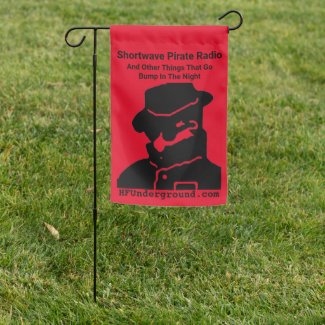When XLR8 came on Monday evening I just happened to be testing a version of the popular PA0RDT active antenna that Chris whipped together for me to try out. It works so well I might not send it back. Or maybe I'll send back an empty paint can and claim the NSA and USPS stole the guts.
I compared the active antenna against the excellent compact RF Systems EMF - a clever thing that's quick and easy to rig up for temporary receive only use. It's made of RG174 shielded coax for both the main antenna and feedline/counterpoise, along with some fancypants impedance transformers on both ends, including one that seems to help with non-directional MW reception.
To get as far as possible away from the usual suburban noisemakers I set everything up on batteries on a metal picnic table in the back yard of our apartment complex - fortunately it's the size of a football field and the middle is around 30 yards from the nearest power lines and flickering metal halide lights that infest the streets and parking lots. I figured the metal table wouldn't hurt the performance of the active antenna, which reportedly does better with a good ground or at least a ground plane for capacitance.
Overall I'd say this variation of the PA0RDT fares as well as the RF Systems EMF across the MW and HF spectrum I tried. However the active antenna needed a little help so I clipped a 6' length of ordinary twisted copper wire to the antenna stub, and either clipped the other end to an overhead tree or just draped it across the ground - the latter actually performed a bit better, with a little less signal and a lot less noise than the vertical orientation. I also draped the RF Systems EMF antenna across the ground to minimize local noise pickup. Too much wire clipped to the active antenna will overload and cause intermod from the local MW flamethrowers like WBAP 820, which broke though a few times on 6950, 6754 aviation weather and 3330 CHU.
A couple of notable examples where the active antenna seemed to fare better than the RF Systems EMF or my usual random wire outdoor antenna: 20m was so quiet on the active antenna I thought it was deaf on that band until I heard the usual hamsters loud and clear, minus the usual noise floor; and WWV on 2500 was unusually clear before dark (around 0130z, 8:30 pm Texas time in summer), much clearer and with less static than I've ever heard on a summer evening with any wire antenna.
I haven't had time to edit the videos I shot while switching between the antennas, and one is 25 minutes long. I was chattering over the videos hoping to avoid having to type in captions later, but there's some wind noise picked up by my video camera because I forgot the wind screen. But it should be an adequate demonstration.
YouTube video demonstrations:PA0RDT active antenna vs RF Systems EMF with Palstar R30C (2 of 3) - 25 minutes long. Skip ahead to 8:30 mark for WWV on 2500 comparison; and 14 minute mark for the rest - you won't miss much.
PA0RDT active antenna vs RF Systems EMF with Palstar R30C (3 of 3) - Only a few minutes, toward end of XLR8 broadcast. Signal had faded a bit but still audible.
Anyway, the PA0RDT design has a lot of potential. Very quiet noise floor compared with older style active antennas I'd tried. It's broadband so no tuning is needed - a big improvement over my older style active antenna. But it does need a quiet location. Fortunately just moving a few yards or feet in any direction may find that sweet spot in a noisy urban/suburban location. The advantage to a short whip or wire is that it won't pick up every bit of local RFI in the area. The disadvantage is less wire in the sky leads to more fading, but it's a fair trade off.



